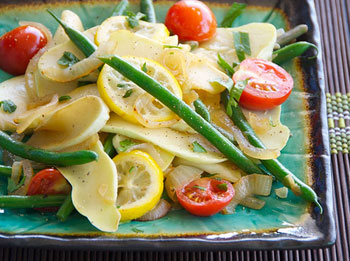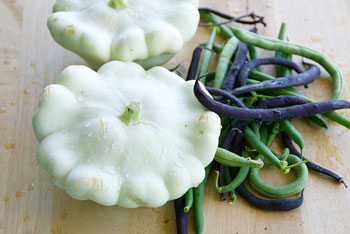 Has this ever happened to you? You're strolling through the farmers' market on a balmy August day when you spy a table heavy with heirloom tomatoes.
Has this ever happened to you? You're strolling through the farmers' market on a balmy August day when you spy a table heavy with heirloom tomatoes.
There's a youthful, striped Green Zebra sitting next to a grandfatherly, bulbous Cherokee tomato the color of red wine. You scoop up a couple of each. Your mind is swimming with juicy possibilities -- tomato and mozzarella salad, tomato and goat cheese tart.
As you're walking toward the farmer to pay for your tomatoes, you spot a perfectly scalloped white patty pan squash. You've never seen a white squash before, so you select three. Then the farmer points out his captivating purple string beans. You say you'll buy a pound of those too. No one passes up purple string beans.
You hand your heavy sacks to the farmer who weighs them and says, "That'll be $28 dollars, please."
You blanch. You only have $20 left in your wallet. What do you do?
Here's my advice. At this point, excuse yourself. Walk to the nearest ATM or hit your kid up for the money. Whatever you do, buy the vegetables. This is a case where they really are worth the price.
What makes heirloom crops so special? Lots of things. I have spoken with many San Diego farmers about heirloom varieties, and most recently with Ari Tenenbaum, master gardener at Revolution Landscape in La Jolla.
 When planting kitchen or community gardens for clients Tenenbaum uses almost exclusively heirloom crops. Why? "We love to show people what kind of diversity there is out there. Most people know about heirloom tomatoes, but they might not know that there's also heirloom peppers, eggplant, squash, and melon too. And [the flavor] is not like anything they have had before."
When planting kitchen or community gardens for clients Tenenbaum uses almost exclusively heirloom crops. Why? "We love to show people what kind of diversity there is out there. Most people know about heirloom tomatoes, but they might not know that there's also heirloom peppers, eggplant, squash, and melon too. And [the flavor] is not like anything they have had before."
Indeed, heirlooms taste the way fruits and vegetables used to taste. That's because heirloom crops are bred primarily for flavor. In contrast, traditional crops are bred for durability – to withstand cross-country truck drives – and for uniformity in size, shape, and even flavor. That's why tomatoes and peppers and corn typically look and taste the same in supermarkets across the country.
Not only do heirloom varieties taste better, but they also benefit the environment: “I personally love heirlooms because they promote bio-diversity (living ecosystems) which is good for the planet," said Tenenbaum.
The day I met Tenenbaum he sent me home with my arms full of heirloom vegetables including Bennings patty pan scallop squash, Hopi purple string beans, watermelon beefsteak tomatoes, and lemon verbena which became today's recipe. This citrus-spiked vegetable saute is the ideal accompaniment to grilled fish, chicken, or steak on a hot summer night. It's also delicious mixed with quinoa or barley for a satisfying vegetarian meal.
If you're still not convinced about paying top dollar for heirloom crops, then consider their fanciful names like "California Wonder" peppers, "Moon and Stars" watermelon, and "Tongues of Fire" beans. I mean, really, who could pass those up?
Sauteed Patty Pan Squash, String Beans, and Tomatoes with Lemon Verbena
Makes 6 side servings
Lemon verbena is an intensely aromatic and flavorful herb that can be found at farmers' markets and some specialty markets. If you can't find it, then you could substitute lemon basil, or use extra lemon zest mixed with parsley or basil. For different herbal flavors, try rosemary, cilantro or fresh oregano.
2 tablespoons olive oil
1 medium sweet onion, such as Vidalia, thinly sliced
1 1/2 pounds patty pan scallop squash, sliced (about 4 cups)
1/2 pound string beans (about 3 cups)
1/4 pound grape or cherry tomatoes, halved (about 1 cup)
1 large lemon, sliced with rind on, seeds removed
The juice of 1/2 large lemon (about 2 teaspoons)
1 tablespoon fresh lemon verbena (or 1 teaspoon dried)
1/4 teaspoon salt
1/4 teaspoon freshly ground black pepper
Warm olive oil in a large skillet or wok over medium-high heat. Add onion and saute 3-4 minutes, or until softened and translucent. Add squash and cook 3-4 minutes, or until lightly browned and softened. Add string beans and cook 3 minutes until just softened. Add tomatoes and cook 2 minutes until wilted. Add remaining ingredients, tossing well until warmed through. The vegetables should be cooked through yet still firm, not mushy. Remove from heat. Serve hot or at room temperature.
Susan Russo is a free lance food writer in San Diego, California. She publishes stories, recipes, and photos on her cooking blog, <Food Blogga and is a regular contributor to NPR’s <Kitchen Window. She is also the author of two upcoming books that will be published in the fall of 2010.

